List of Apollo missions
The Apollo program was the third United States human spaceflight program carried out by the National Aeronautics and Space Administration (NASA), which accomplished landing the first humans on the Moon from 1969 to 1972.[1] During the Apollo 11 mission, astronauts Neil Armstrong and Buzz Aldrin landed their Apollo Lunar Module (LM) and walked on the lunar surface, while Michael Collins remained in lunar orbit in the command and service module (CSM), and all three landed safely on Earth on July 24, 1969.[2] Five subsequent Apollo missions also landed astronauts on the Moon, the last in December 1972. In these six spaceflights, twelve men walked on the Moon.[3]
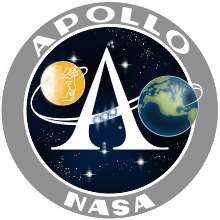
Apollo ran from 1961 to 1972, with the first crewed flight in 1968. It achieved its goal of crewed lunar landing, despite the major setback of a 1967 Apollo 1 cabin fire that killed the entire crew during a prelaunch test.[4] After the first landing, sufficient flight hardware remained for nine follow-up landings with a plan for extended lunar geological and astrophysical exploration. Budget cuts forced the cancellation of three of these.[5] Five of the remaining six missions achieved successful landings, but the Apollo 13 landing was prevented by an oxygen tank explosion in transit to the Moon, which damaged the CSM's propulsion and life support. The crew returned to Earth safely by using the Lunar Module as a "lifeboat" for these functions.[6] Apollo used Saturn family rockets as launch vehicles, which were also used for an Apollo Applications Program, which consisted of Skylab, a space station that supported three crewed missions from 1973 through 1974, and the Apollo–Soyuz Test Project, a joint Earth orbit mission with the Soviet Union in 1975.[7]
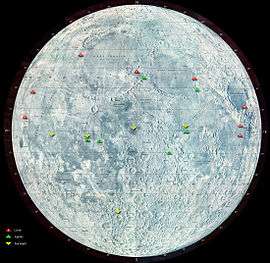
Apollo set several major human spaceflight milestones. It stands alone in sending crewed missions beyond low Earth orbit.[3] Apollo 8 was the first crewed spacecraft to orbit another celestial body, while the final Apollo 17 mission marked the sixth Moon landing and the ninth crewed mission beyond low Earth orbit. The program returned 842 pounds (382 kg) of lunar rocks and soil to Earth, greatly contributing to the understanding of the Moon's composition and geological history.[8] The program laid the foundation for NASA's subsequent human spaceflight capability. Apollo also spurred advances in many areas of technology incidental to rocketry and crewed spaceflight, including avionics, telecommunications, and computers.[9]
The Apollo program used four types of launch vehicles. The first was the Little Joe II, which was used for uncrewed suborbital launch escape system development.[10] The second is the Saturn I, which was used for uncrewed suborbital and orbital hardware development.[11] The third is the Saturn IB which was used for preparatory uncrewed missions and Apollo 7.[12] Last, the Saturn V which was used for uncrewed and crewed Earth orbit and lunar missions.[13] The Marshall Space Flight Center, which designed the Saturn rockets, referred to the flights as Saturn-Apollo (SA), while Kennedy Space Center referred to the flights as Apollo-Saturn (AS). This is why the uncrewed Saturn I flights are referred to as SA and the uncrewed Saturn IB are referred to as AS.
Alphabetical mission types
The Apollo program required sequential testing of several major mission elements in the runup to a crewed lunar landing. An alphabetical list of major mission types was proposed by Owen Maynard in September 1967.[14][15] Two "A-type" missions performed uncrewed tests of the CSM and the Saturn V, and one B-type mission performed an uncrewed test of the LM. The C-type mission, the first crewed flight of the CSM in Earth orbit, was performed by Apollo 7.
The list was revised upon George Low's proposal to commit a mission to lunar orbit ahead of schedule, an idea influenced by the status of the CSM as a proven craft and production delays of the LM.[16] Apollo 8 was reclassified from its original assignment as a D-type mission, a test of the complete CSM/LM spacecraft in Earth orbit, to a "C-prime" mission which would fly humans to the Moon. Once complete, it obviated the need for the E-type objective of a medium Earth orbital test. The D-type mission was instead performed by Apollo 9; the F-type mission, Apollo 10, flew the CSM/LM spacecraft to the Moon for final testing, without landing. The G-type mission, Apollo 11, performed the first lunar landing, the central goal of the program.
The initial A-G[14][17] list was expanded to include later mission types:[1]:466 H-type missions—Apollo 12, 13 (planned) and 14—would perform precision landings, and J-type missions—Apollo 15, 16 and 17—would perform thorough scientific investigation. The I-type objective, which called for extended lunar orbital surveillance of the Moon,[18] was incorporated into the J-type missions.[1]:466
| Mission Type | Missions | Description |
|---|---|---|
| A | Apollo 4 Apollo 6 |
"Unmanned flights of launch vehicles and the CSM, to demonstrate the adequacy of their design and to certify safety for men."[17][lower-alpha 1] |
| B | Apollo 5 | "Unmanned flight of the LM, to demonstrate the adequacy of its design and to certify its safety for men."[17] |
| C | Apollo 7 | "Manned flight to demonstrate performance and operability of the CSM."[17] |
| C' | Apollo 8 | "Command and service module manned flight demonstration in lunar orbit."[1]:466 |
| D | Apollo 9 | "Manned flight of the complete lunar landing mission vehicle in low Earth orbit to demonstrate operability of all the equipment and (insofar as could be done in Earth orbit) to perform the maneuvers involved in the ultimate mission."[17] |
| E | — | "Manned flight of the complete lunar landing mission vehicle in Earth orbit to great distances from Earth."[17] |
| F | Apollo 10 | "A complete mission except for the final descent to and landing on the lunar surface."[17] |
| G | Apollo 11 | "The initial lunar landing mission."[17] |
| H | Apollo 12 Apollo 13 (planned) Apollo 14 |
"Precision manned lunar landing demonstration and systematic lunar exploration."[1]:466 |
| I | — | "Reserved for lunar survey missions (not used)."[18] |
| J | Apollo 15 Apollo 16 Apollo 17 |
"Extensive scientific investigation of Moon on lunar surface and from lunar orbit."[1]:466 |
Test flights
Uncrewed test missions
From 1961 to 1968, the Saturn launch vehicles and components of the Apollo spacecraft were tested in uncrewed flights.
There was some incongruity in the numbering and naming of the first three uncrewed Apollo-Saturn (AS), or Apollo flights. This is due to AS-204 being renamed to Apollo 1 posthumously. This crewed flight was to have followed the first three uncrewed flights. After the fire which killed the AS-204 crew on the pad during a test and training exercise, uncrewed Apollo flights resumed to test the Saturn V launch vehicle and the Lunar Module; these were designated Apollo 4, 5 and 6. The first crewed Apollo mission was thus Apollo 7. Simple "Apollo" numbers were never assigned to the first three uncrewed flights, although renaming AS-201, AS-202, and AS-203 as Apollo 1-A, Apollo 2 and Apollo 3, had been briefly considered.[4]
| Mission | LV Serial No | Launch | Remarks | Refs |
|---|---|---|---|---|
| SA-1 | Saturn I
SA-1 |
27 October 1961
15:06 GMT Launch Complex 34 |
Test of Saturn I first stage S-I; dummy upper stages carried water | [1][19][20] |
| SA-2 | Saturn I
SA-2 |
25 April 1962
14:00 GMT Launch Complex 34 |
Dummy upper stages released 22,900 U.S. gallons (86,685 l) of water into upper atmosphere, to investigate effects on radio transmission and changes in local weather conditions | [1][19][20] |
| SA-3 | Saturn I
SA-3 |
16 November 1962
17:45 GMT Launch Complex 34 |
Repeat of SA-2 mission | [1][19][20] |
| SA-4 | Saturn I
SA-4 |
28 March 1963
20:11 GMT Launch Complex 34 |
Test premature shutdown of a single S-I engine | [1][19][20] |
| SA-5 | Saturn I
SA-5 |
29 January 1964
16:25 GMT Launch Complex 37B |
First flight of live second stage. First orbital flight. | [1][19][20] |
| AS-101 | Saturn I
SA-6 |
28 May 1964
17:07 GMT Launch Complex 37B |
Tested first boilerplate Apollo command and service module (CSM) for structural integrity | [1][20] |
| AS-102 | Saturn I
SA-7 |
18 September 1964
17:22 GMT Launch Complex 37B |
Carried first programmable-in-flight computer on the Saturn I vehicle; last launch vehicle development flight | [1][20] |
| AS-103 | Saturn I
SA-9 |
16 February 1965
14:37 GMT Launch Complex 37B |
Carried first Pegasus micrometeorite satellite (Pegasus A) in addition to boilerplate CSM | [1][20] |
| AS-104 | Saturn I
SA-8 |
25 May 1965
07:35 GMT Launch Complex 37B |
Carried Pegasus B and boilerplate CSM | [1][20] |
| AS-105 | Saturn I
SA-10 |
30 July 1965
13:00 GMT Launch Complex 37B |
Carried Pegasus C and boilerplate CSM | [1][20] |
| AS-201 | Saturn IB AS-201 | 26 February 1966
16:12 GMT Launch Complex 34 |
First test of Saturn IB. First flight of Block I Apollo CSM. After a suborbital flight the CM landed in the Atlantic Ocean demonstrating the heat shield; however a propellant pressure loss caused premature SM engine shutdown. | [1][4][19][20] |
| AS-203 | Saturn IB AS-203 | 5 July 1966
14:53 GMT Launch Complex 37B |
No Apollo spacecraft carried; successfully verified restartable S-IVB stage design for Saturn V. Additional testing designed to rupture the tank inadvertently destroyed the stage. | [1][4][19][20] |
| AS-202 | Saturn IB AS-202 | 25 August 1966
17:15 GMT Launch Complex 34 |
Longer duration suborbital to Pacific Ocean splashdown. CM heat shield tested to higher speed and successful SM firings. | [1][4][19][20] |
| Apollo 4 | Saturn V AS-501 | 9 November 1967
12:00 GMT |
First flight of Saturn V rocket; successfully demonstrated S-IVB third stage restart and tested CM heat shield at lunar re-entry speeds. | [1][19][20] |
| Apollo 5 | Saturn IB AS-204 | 22 January 1968
22:48 GMT Launch Complex 37B |
First flight of LM; successfully fired descent engine and ascent engine; demonstrated "fire-in-the-hole" landing abort test. | [1][19][20] |
| Apollo 6 | Saturn V AS-502 | 4 April 1968
16:12 GMT |
Second flight of Saturn V; severe "pogo" vibrations caused two second-stage engines to shut down prematurely, and third stage restart to fail. SM engine used to achieve high-speed re-entry, though less than Apollo 4. NASA identified vibration fixes and declared Saturn V man-rated. | [1][19][20] |
Uncrewed launch escape system tests
From August 1963 to January 1966 a number of tests were conducted for development of the launch escape system (LES). These included simulated "pad aborts", which might occur while the Apollo-Saturn space vehicle was still on the launch pad, and flights on the Little Joe II rocket to simulate Mode I aborts which might occur while the vehicle was in the air.[1]
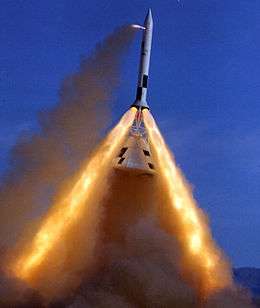
| Mission | Launch date and vehicle if used |
Launch time | Remarks | Refs |
|---|---|---|---|---|
| QTV | 28 August 1963 Little Joe II |
13:05 GMT | Little Joe II qualification test | [1][20] |
| Pad Abort Test 1 | 7 November 1963 | 16:00 GMT | Launch escape system (LES) abort test from launch pad | [1][20] |
| A-001 | 13 May 1964 Little Joe II |
13:00 GMT | LES transonic test, success except for parachute failure | [1][20] |
| A-002 | 8 December 1964 | 15:00 GMT | LES maximum altitude, Max-Q abort test | [1][20] |
| A-003 | 19 May 1965 | 13:01 GMT | LES canard maximum altitude abort test | [1][20] |
| Pad Abort Test 2 | 29 June 1965 | 13:00 GMT | LES pad abort test of near Block-I CM | [1][20] |
| A-004 | 20 January 1966 | 15:17 GMT | LES test of maximum weight, tumbling Block-I CM | [1][20] |
Thermal-vacuum tests
| Number | Date | Vehicle | Crew | Notes | Refs |
|---|---|---|---|---|---|
| 1 | July 26, 1966 | spacecraft 008 (Block 1) |
N/A |
|
[21] |
| 2 | August 2, 1966 | spacecraft 008 (Block 1) |
Volunteers from MSC |
|
[21] |
| 3 | October 26, 1966 | spacecraft 008 (Block 1) |
Two astronauts and one military pilot |
|
[21] |
| 4 | June 10, 1968 | 2TV-1[lower-alpha 2] (Block II) |
N/A |
|
[21] |
| 5 | June 16, 1968 | 2TV-1[lower-alpha 2] (Block II) |
|
|
[22] |
| 6 | August 24, 1968 | 2TV-1[lower-alpha 2] (Block II) |
N/A |
|
[21] |
| 7 | September 4, 1968 | 2TV-1[lower-alpha 2] (Block II) |
Military pilots assigned to NASA |
|
[21] |
| 8 | April 1, 1968 | LTA-8 [lower-alpha 3] (Lunar Module) |
N/A |
|
[21] |
| 9 | May 5, 1968 | LTA-8 [lower-alpha 3] (Lunar Module) |
|
|
[21][23][24] |
| 10 | May 24, 1968 | LTA-8 [lower-alpha 3] (Lunar Module) |
N/A |
|
[21][23][24] |
| 11 | May 30, 1968 | LTA-8 [lower-alpha 3] (Lunar Module) |
N/A |
|
[21][23][24] |
| 12 | June 5, 1968 | LTA-8 [lower-alpha 3] (Lunar Module) |
|
21 hours simulation time | [21][23][24] |
Crewed Apollo missions
The Block I CSM spacecraft did not have capability to fly with the LM, and the three crew positions were designated Command Pilot, Senior Pilot, and Pilot, based on U.S. Air Force pilot ratings. The Block II spacecraft was designed to fly with the Lunar Module, so the corresponding crew positions were designated Commander, Command Module Pilot, and Lunar Module Pilot regardless of whether a Lunar Module was present or not on any mission.[25]
A total of fifteen Saturn V vehicles were ordered (through AS-515), which would have been enough for three more Moon landing missions through Apollo 20. This flight was cancelled around the time of the Apollo 11 first landing mission to make the launch vehicle available for the Skylab space station. Shortly thereafter, Apollo 18 and 19 were cancelled in response to Congressional cuts in NASA's budget.[7]
Several of the missions involved extravehicular activity (EVA), spacewalks or moonwalks outside of the spacecraft. These were of three types: testing the lunar EVA suit in Earth orbit (Apollo 9), exploring the lunar surface, and retrieving film canisters from the Scientific Instrument Module stored in the Service Module.[26]
| Mission | Patch | Launch date | Crew | Launch vehicle[lower-alpha 4] | CM name | LM name | Duration | Remarks | Refs |
|---|---|---|---|---|---|---|---|---|---|
| Apollo 1 | 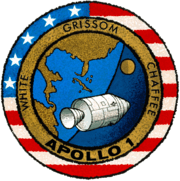 |
21 February 1967
Launch Complex 34 (planned) |
Gus Grissom Ed White Roger B. Chaffee |
Saturn IB (AS-204) |
N/A | N/A | N/A | Never launched. On 27 January 1967, a fire in the command module during a launch pad test killed the crew and destroyed the module. This flight was originally designated AS-204, and was renamed to Apollo 1 at the request of the crew's families. | [1][19][27][28][29] |
| Apollo 7 | 11 October 1968
15:02 GMT Launch Complex 34 |
Wally Schirra Donn F. Eisele Walter Cunningham |
Saturn IB (AS-205) |
N/A | N/A | 10d 20h 09m 03s |
Test flight of Block II CSM in Earth orbit; included first live TV broadcast from American spacecraft. | [1][19][30][31][32] | |
| Apollo 8 | 21 December 1968
12:51 GMT |
Frank Borman James Lovell William Anders |
Saturn V
(AS-503) |
N/A | N/A | 06d 03h
00m 42s |
First circumlunar flight of CSM, had ten lunar orbits in 20 hours. First crewed flight of Saturn V. | [1][19][33][34][35] | |
| Apollo 9 | 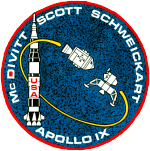 |
3 March 1969
16:00 GMT |
James McDivitt David Scott Rusty Schweickart |
Saturn V
(AS-504) |
Gumdrop | Spider | 10d 01h
00m 54s |
First crewed flight test of Lunar Module; tested propulsion, rendezvous and docking. EVA tested the Portable Life Support System (PLSS). | [1][19][36][37][38] |
| Apollo 10 | 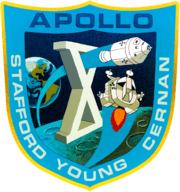 |
18 May 1969
16:49 GMT |
Thomas P. Stafford John Young Eugene Cernan |
Saturn V
(AS-505) |
Charlie Brown | Snoopy | 08d 00h
03m 23s |
"Dress rehearsal" for lunar landing. The LM descended to 8.4 nautical miles (15.6 km) from lunar surface. | [1][19][39][40][41] |
| Apollo 11 | 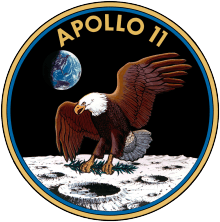 |
16 July 1969
13:32 GMT |
Neil Armstrong Michael Collins Edwin "Buzz" Aldrin |
Saturn V
(AS-506) |
Columbia | Eagle | 08d 03h 18m 35s |
First crewed landing in Sea of Tranquility; including a single surface EVA. | [1][19][2][42] |
| Apollo 12 |  |
14 November 1969
16:22 GMT |
Charles (Pete) Conrad Richard F. Gordon Jr. Alan Bean |
Saturn V
(AS-507) |
Yankee Clipper | Intrepid | 10d 04h 36m 24s |
First precise Moon landing in Ocean of Storms near Surveyor 3 probe. Two surface EVAs and returned parts of Surveyor to Earth. | [1][19][43][44] |
| Apollo 13 | 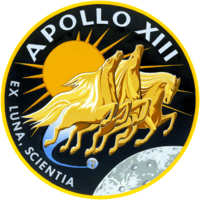 |
11 April 1970
19:13 GMT |
James Lovell Jack Swigert Fred Haise |
Saturn V
(AS-508) |
Odyssey | Aquarius | 05d 22h 54m 41s |
Intended Fra Mauro landing cancelled after SM oxygen tank exploded. LM used as "lifeboat" for safe crew return. First S-IVB stage impact on Moon for active seismic test. | [1][19][45][6] |
| Apollo 14 | 31 January 1971
21:03 GMT |
Alan Shepard Stuart Roosa Edgar Mitchell |
Saturn V
(AS-509) |
Kitty Hawk | Antares | 09d 00h 01m 58s |
Successful Fra Mauro landing. Broadcast first color TV images from lunar surface. Conducted first materials science experiments in space. Conducted two surface EVAs. | [1][19][46][47] | |
| Apollo 15 | 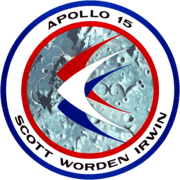 |
26 July 1971
13:34 GMT |
David Scott Alfred Worden James Irwin |
Saturn V
(AS-510) |
Endeavour | Falcon | 12d 07h 11m 53s |
Landing at Hadley–Apennine. First extended LM, three-day lunar stay. First use of Lunar Roving Vehicle. Conducted 3 lunar surface EVAs and one deep space EVA on return to retrieve orbital camera film from SM. | [1][19][48][49] |
| Apollo 16 |  |
16 April 1972
17:54 GMT |
John Young Ken Mattingly Charles Duke |
Saturn V
(AS-511) |
Casper | Orion | 11d 01h 51m 05s |
Landing in Descartes Highlands. Conducted 3 lunar EVAs and one deep space EVA. | [1][19][50][51] |
| Apollo 17 | 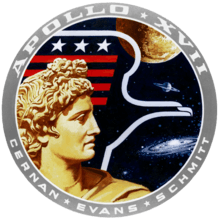 |
7 December 1972
05:33 GMT |
Eugene Cernan Ronald Evans Harrison Schmitt |
Saturn V
(AS-512) |
America | Challenger | 12d 13h 51m 59s |
Landing at Taurus–Littrow. First professional geologist on the Moon. First night launch. Conducted 3 lunar EVAs and one deep space EVA. | [1][19][20][52] |
Canceled missions
Several planned missions of the Apollo program of the 1960s and 1970s were canceled for a variety of reasons, including changes in technical direction, the Apollo 1 fire, hardware delays, and budget limitations.
| Mission name/designation | Commander | Command Module Pilot | Lunar Module Pilot | Mission date | Date of cancellation | Remarks | Refs |
|---|---|---|---|---|---|---|---|
| AS-205 (a.k.a. Apollo 2) | Walter Schirra | Donn Eisele | Walter Cunningham | August 1967 | 22 December 1966 | Deemed unnecessary; crew flew on Apollo 7 | [53] |
| Apollo 18 | Richard Gordon | Vance Brand | Harrison Schmitt | February 1972 | 2 September 1970 | Budget cuts | [5][54] |
| Apollo 19 | Fred Haise | William Pogue | Gerald Carr | July 1972 | 2 September 1970 | Budget cuts | [5][54] |
| Apollo 20 | Pete Conrad or Stuart Roosa | Paul Weitz | Jack Lousma | December 1972 | 4 January 1970 | Launch vehicle needed to launch Skylab | [5][54][55] |
Post-Apollo missions using Apollo hardware
There were several missions that used Apollo hardware after the cancellation of Apollo 18, Apollo 19, and Apollo 20.[56]
| Order | Launch | Mission | Launch vehicle | Commander | Pilot | Science Pilot | Duration | Remarks | Refs |
|---|---|---|---|---|---|---|---|---|---|
| 1 | 14 May 1973
17:30 UTC Launch Complex 39A |
Skylab 1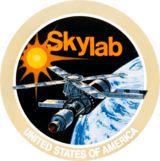 |
Saturn V
(AS-513 minus S-IVB) |
N/A | N/A | N/A | N/A | Uncrewed launch of the Skylab space station. The space station was later crewed by missions Skylab 2, Skylab 3 and Skylab 4. | [19] |
| 2 | 25 May 1973
13:00 GMT Launch Complex 39B |
Skylab 2[57]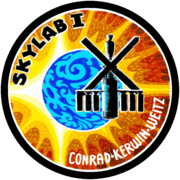 |
Saturn IB
(AS-206) |
Pete Conrad | Paul J. Weitz | Joseph P. Kerwin | 28d 00h 49m 49s |
First crew of the Skylab space station. | [19] |
| 3 | 28 July 1973
11:10 GMT Launch Complex 39B |
Skylab 3[57]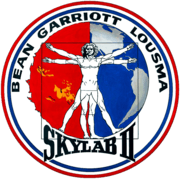 |
Saturn IB
(AS-207) |
Alan Bean | Jack R. Lousma | Owen K. Garriott | 59d 11h 09m 34s |
Second Skylab station crew. Reaction Control System thruster malfunction nearly necessitated a Rescue Mission. | [19] |
| 4 | 16 November 1973
14:01 GMT Launch Complex 39B |
Skylab 4[57]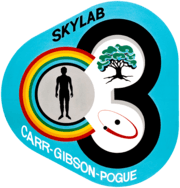 |
Saturn IB
(AS-208) |
Gerald P. Carr | William R. Pogue | Edward Gibson | 84d 01h 15m 31s |
Third and final Skylab crew. Penultimate flight of Apollo. | [19] |
| 5 | 15 July 1975
12:20 GMT Launch Complex 39B |
Apollo-Soyuz Test Project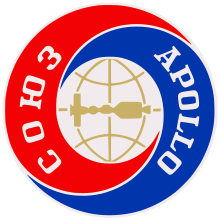 |
Saturn IB
(AS-210) |
Thomas P. Stafford | Vance D. Brand | Deke Slayton | 09d 01h 28m |
Final flight of both Apollo and the Saturn IB. Rendezvous and docking with Soyuz 19 spacecraft. The inadvertent entry of toxic gases into the cabin atmosphere created a potentially life-threatening health risk to the astronauts during re-entry. | [19] |
Notes
- Although the A-type designation was used in official documents to refer only to Apollo 4 and Apollo 6,[1]:466 specifically their uncrewed orbital flights of the CSM and use of the Saturn V rocket, Samuel C. Phillips also used the A-type designation to refer to AS-201, AS-203 and AS-202: "A. Unmanned flights of launch vehicles and the CSM, to demonstrate the adequacy of their design and to certify safety for men. Five of these flights were flown between February 1966 and April 1968; Apollo 6 was the last."[17]
- Block II Thermal Vacuum no.1
- Lunar Module Test Article no.8
- Serial number displayed in parentheses
References
![]()
- Apollo Program Summary Report (PDF) (Report). National Aeronautics and Space Administration. April 1975. JSC-09423. Retrieved 29 September 2017.
- "Apollo 11 (AS-506)". Smithsonian National Air and Space Museum. Retrieved 10 March 2020.
- Riley, Christopher (15 December 2012). "Apollo 40 years on: how the moon missions changed the world for ever". The Guardian. Retrieved 1 January 2019.
- Teitel, Amy (28 October 2013). "What Happened to Apollos 2 and 3?". Popular Science. Retrieved 3 March 2018.
- Williams, David (11 December 2003). "Apollo 18 through 20 - The Cancelled Missions". National Aeronautics and Space Administration. Retrieved 3 March 2018.
- Apollo 13 Mission Report (PDF) (Report). National Aeronautics and Space Administration. September 1970. MSC-02680. Retrieved 29 September 2017.
- Silber, Kennith (16 July 2009). "Down to Earth: The Apollo Moon Missions That Never Were". Scientific American. Retrieved 1 January 2019.
- "Lunar Rocks and Soils from Apollo Missions". National Aeronautics and Space Administration. 1 September 2016. Retrieved 30 January 2019.
- Gaudin, Sharon (20 July 2009). "NASA's Apollo technology has changed history". Computerworld. Retrieved 1 January 2019.
- Bongat, Orlando (16 September 2011). "Little Joe II". National Aeronautics and Space Administration. Retrieved 30 January 2019.
- "Rocket, Launch Vehicle, Test, Saturn I, Block 1". Smithsonian National Air and Space Museum. 2016-03-13. Retrieved 30 January 2019.
- Portree, David S. F. (16 September 2013). "A Forgotten Rocket: The Saturn IB". Wired. Wired (magazine). Retrieved 30 January 2019.
- Bongat, Orlando. "Saturn V". National Aeronautics and Space Administration.
- Brooks, Courtney G.; Grimwood, James M.; Swenson, Loyd S. (1979). "Tragedy and Recovery". Chariots for Apollo: A History of Manned Lunar Spacecraft. NASA.
- Murray, Charles; Cox, Catherine Bly (1989). Apollo: The Race to the Moon. Simon and Schuster. pp. 315–16. ISBN 9780671706258.
- Cortright, Edgar M., ed. (2019). Apollo Expeditions to the Moon. Dover. p. 171. ISBN 9780486836522.
- Cortright, Edgar M., ed. (2019). Apollo Expeditions to the Moon. Dover. p. 172. ISBN 9780486836522.
- "Part 2(D) – July through September 1967". The Apollo Spacecraft – A Chronology. Volume IV. NASA. 1975. Retrieved 2008-01-29.
- Hallion & Crouch, pp. 153–159
- Apollo 17 Mission Report (PDF) (Report). National Aeronautics and Space Administration. March 1973. JSC-07904. Retrieved 21 September 2017.
- https://ntrs.nasa.gov/archive/nasa/casi.ntrs.nasa.gov/19740012430.pdf
- http://www.angelfire.com/ma3/spacepatch/2TV1.html
- "Lta8".
- "Lunar Module LTA-8". Archived from the original on 2018-04-09. Retrieved 2018-04-09.
- Shayler, David (26 August 2002). Apollo: The Lost and Forgotten Missions. Springer Science & Business Media. pp. 117, 124–125. ISBN 9781852335755.
- Evans, Ben (17 December 2017). "Walking in the Void: 45 Years Since the Last Deep-Space EVA". AmericaSpace. Retrieved 30 January 2019.
- "Apollo 1". National Aeronautics and Space Administration. 14 June 2012. Retrieved 15 February 2017.
- "Apollo 1 (AS-204)". Smithsonian National Air and Space Museum. Archived from the original on 4 July 2017. Retrieved 21 September 2017.
- Garber, Steve (10 September 2015). "Apollo-1 (AS-204)". National Aeronautics and Space Administration. Retrieved 29 September 2017.
- Ryba, Jeanne (8 July 2009). "Apollo 7". National Aeronautics and Space Administration. Retrieved 15 February 2017.
- "Apollo 7 (AS-205)". Smithsonian National Air and Space Museum. Archived from the original on 4 July 2017. Retrieved 21 September 2017.
- Apollo 8 Mission Report (PDF) (Report). National Aeronautics and Space Administration. February 1969. MSC-PA-R-69-1. Retrieved 29 September 2017.
- Ryba, Jeanne (8 July 2009). "Apollo 8". National Aeronautics and Space Administration. Retrieved 12 September 2017.
- "Apollo 8 (AS-503)". Smithsonian National Air and Space Museum. Archived from the original on 4 July 2017. Retrieved 21 September 2017.
- Apollo 8 Mission Report (PDF) (Report). National Aeronautics and Space Administration. February 1969. MSC-PA-R-69-1. Retrieved 29 September 2017.
- "Apollo 9". National Aeronautics and Space Administration. 8 July 2009. Retrieved 12 September 2017.
- "Apollo 9 (AS-504)". Smithsonian National Air and Space Museum. Archived from the original on 4 July 2017. Retrieved 21 September 2017.
- Apollo 9 Mission Report (PDF) (Report). National Aeronautics and Space Administration. May 1969. MSC-PA-R-69-2. Retrieved 29 September 2017.
- "Apollo 10". National Aeronautics and Space Administration. 8 July 2009. Retrieved 12 September 2017.
- "Apollo 10 (AS-505)". Smithsonian National Air and Space Museum. Archived from the original on 4 July 2017. Retrieved 21 September 2017.
- Apollo 10 Mission Report (PDF) (Report). National Aeronautics and Space Administration. August 1969. MSC-00126. Retrieved 29 September 2017.
- Apollo 11 Mission Report (PDF) (Report). National Aeronautics and Space Administration. November 1969. MSC-00171. Retrieved 29 September 2017.
- "Apollo 12 (AS-507)". Smithsonian National Air and Space Museum. Retrieved 21 September 2017.
- Apollo 12 Mission Report (PDF) (Report). National Aeronautics and Space Administration. March 1970. MSC-01855. Retrieved 29 September 2017.
- "Apollo 13 (AS-508)". Smithsonian National Air and Space Museum. Retrieved 21 September 2017.
- "Apollo 14 (AS-509)". Smithsonian National Air and Space Museum. Retrieved 21 September 2017.
- Apollo 14 Mission Report (PDF) (Report). National Aeronautics and Space Administration. May 1971. MSC-04112. Retrieved 29 September 2017.
- "Apollo 15 (AS-510)". Smithsonian National Air and Space Museum. Retrieved 21 September 2017.
- Apollo 15 Mission Report (PDF) (Report). National Aeronautics and Space Administration. December 1971. MSC-05161. Retrieved 29 September 2017.
- "Apollo 16 (AS-511)". Smithsonian National Air and Space Museum. Retrieved 21 September 2017.
- Apollo 16 Mission Report (PDF) (Report). National Aeronautics and Space Administration. December 1971. MSC-07230. Retrieved 29 September 2017.
- "Apollo 17 (AS-512)". Smithsonian National Air and Space Museum. Retrieved 21 September 2017.
- Wade, Mark. "APOLLO 7: AS-205". astronautix. Retrieved 3 March 2018.
- Rousseau, Steve (2 September 2011). "Why Apollo Really Stopped at 17". Popular Mechanics. Retrieved 3 March 2018.
- "Apollo 20". Astronautix. Retrieved March 15, 2018.
- "The Skylab Program". NASA History Office. October 22, 2004. Retrieved March 15, 2018.
- Due to a management error, the Skylab mission patches were incorrectly designed using an inconsistent mission numbering scheme."Skylab Numbering Fiasco". WilliamPogue.com. Archived from the original on 2009-02-08. Retrieved 2019-03-08.
Bibliography
- Hallion, Richard P.; Crouch, Tom D. (1979). Apollo: Ten Years Since Tranquility Base. Apollo: Ten Years Since Tranquillity Base. Smithsonian Institution. Bibcode:1979atys.book.....H. ISBN 978-0874745054.
.jpg)
